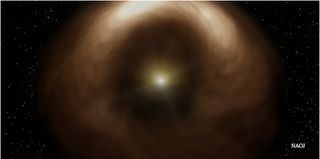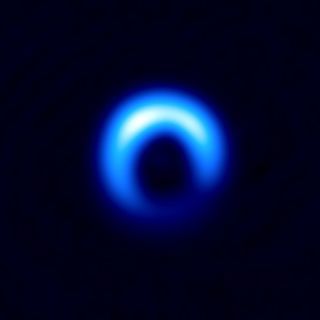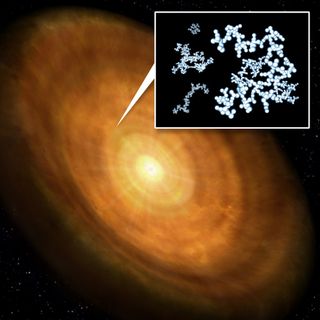'Fluffy' Seeds Grow Into Baby Planets

How do baby planets form? This question would seem to have a simple answer: You take a huge quantity of dust in orbit around a young star, compress it and — hey presto! — the seed of a planetary newborn is formed, around which its gravity pulls in more and more material to bulk it up into a full-blown protoplanet.
Though this makes logical sense, many puzzles remain and astronomers still aren't quite sure how the gas and dust around young stars really forms planets. This issue is the basis of a decades-long mystery underlying planetary formation models, but we are closing in on some answers.
Now, the largest radio observatory on the planet has studied the light coming from a young star in an effort to understand the initiation of planet building and astronomers think they've added an important clue to the mystery surrounding the evolution of planets.
RELATED: A Nearby Star Is Birthing a Massive Icy World
The Atacama Large Millimeter/submillimeter Array in Chile was used to study a specific type of polarization of radio waves coming from the 5-million-year-old star HD 142527. The star, which is approximately double the mass of our sun and located 500 light-years away, possesses a ring of dust and gas that astronomers believe forms the building blocks of a planetary system. But how this dust will turn from microscopic specks into huge rocky planets measuring thousands of miles across is a quandary.

Get the Space.com Newsletter
Breaking space news, the latest updates on rocket launches, skywatching events and more!
As these grains of dust surrounding HD 142527 are basically the "seeds" of future exoplanets, Akimasa Kataoka, of Heidelberg University and the National Astronomical Observatory of Japan (NAOJ), and his team used ALMA's precise instrumentation to study the orientation of the polarization of radio waves coming from the dusty ring.
Radio waves are emitted by the star and then scattered by particles in the ring. By looking at this scattered emission, information about the particles within the ring leave a "fingerprint." In this case, Kataoka was able to discern the size of the dust particles from their polarization fingerprint and he stumbled upon a surprise: The individual dust particles were a lot smaller than previous studies assumed. It turns out that the basic dusty grains from which planets will form are only 150 micrometers wide — that's roughly half the size of a grain of table salt and 10 times smaller than previous estimates.
RELATED: Protoplanetary Disk Could Reveal Planetary Abortion
This presents a problem with previous planetary formation models and also, possibly, points to a tantalizing planetary formation mechanism.
"In the previous studies, astronomers have estimated the size based on radio emissions assuming hypothetical spherical dust particles," said Kataoka in a statement.

This new research suggests that far from being simple spherical particles, the dust particles are "fluffy"; many small 150 micrometer-size particles clump together to form larger and more complex dust particles. Therefore, previous astronomical studies that have detected larger particles are actually fluffy agglomerations of smaller particles. And the mechanism by which these particles clump together could form the fundamental mechanism that triggers the initiation of planet birth.
RELATED: 'Baby Earth 2.0' Found in Young Star's Crib
"Thanks to ALMA's high sensitivity, we have detected such a tiny signal to derive information about the size and shape of the dust particles," said Kataoka. "This is the very first step in the research on dust evolution with polarimetry, and I believe the future progress will be full of excitement."
According to previous research by Kataoka, these "fluffy dust aggregates" are formed after being compressed by radiation pressure from the young star. Eventually, these aggregates become massive enough to attract more material under their own gravitation, ultimately creating the seeds of planets.
Originally published on Seeker.
Join our Space Forums to keep talking space on the latest missions, night sky and more! And if you have a news tip, correction or comment, let us know at: community@space.com.
Ian O'Neill is a media relations specialist at NASA's Jet Propulsion Laboratory (JPL) in Southern California. Prior to joining JPL, he served as editor for the Astronomical Society of the Pacific‘s Mercury magazine and Mercury Online and contributed articles to a number of other publications, including Space.com, Space.com, Live Science, HISTORY.com, Scientific American. Ian holds a Ph.D in solar physics and a master's degree in planetary and space physics.
